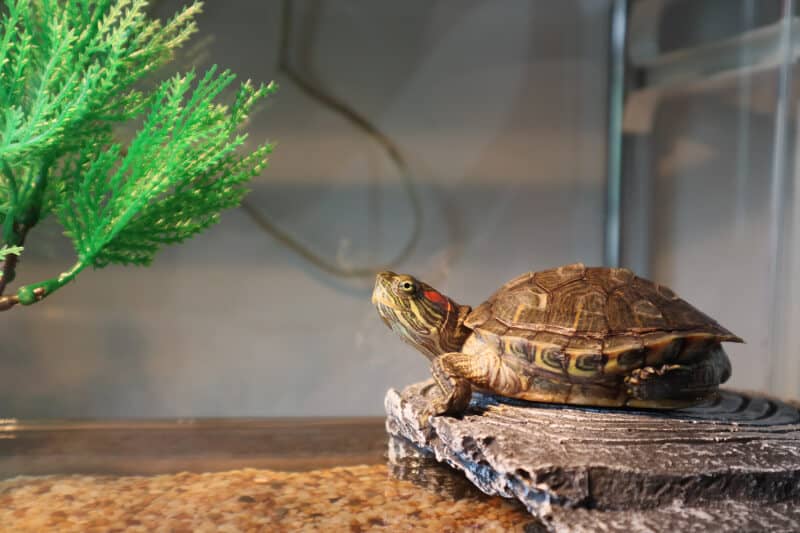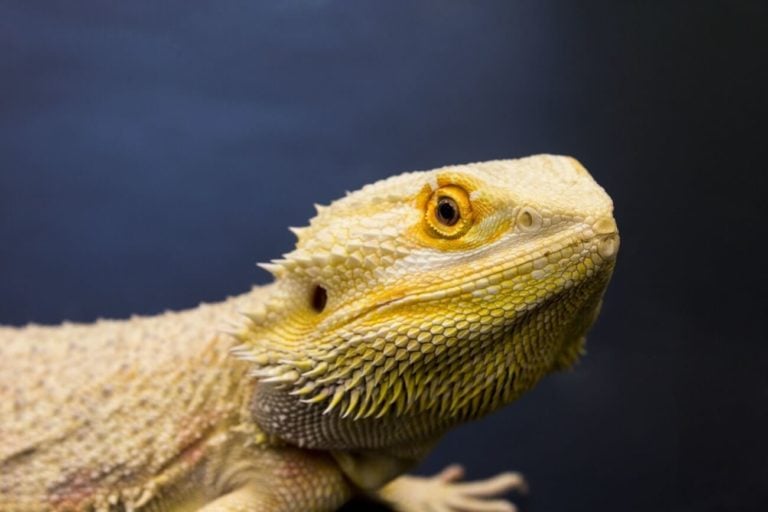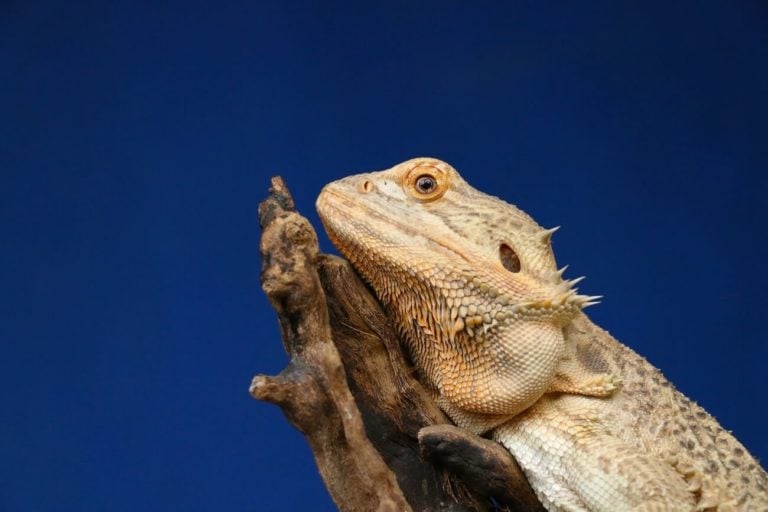Picking one of the best live plants for turtle tanks is important if you’ve been planning on adding vegetation to the habitat. But unfortunately, many owners aren’t sure where to start (there are a lot of plants after all).
This guide will teach you what species to consider, and what makes them good choices.
The Best Plants For Turtle Tanks (brief lead in for the following subsections)
There are a number of different live plants for turtle tanks that can be considered if you want to spruce up your pet’s habitat. This list will help you choose the right species for you.
1. Amazon Sword
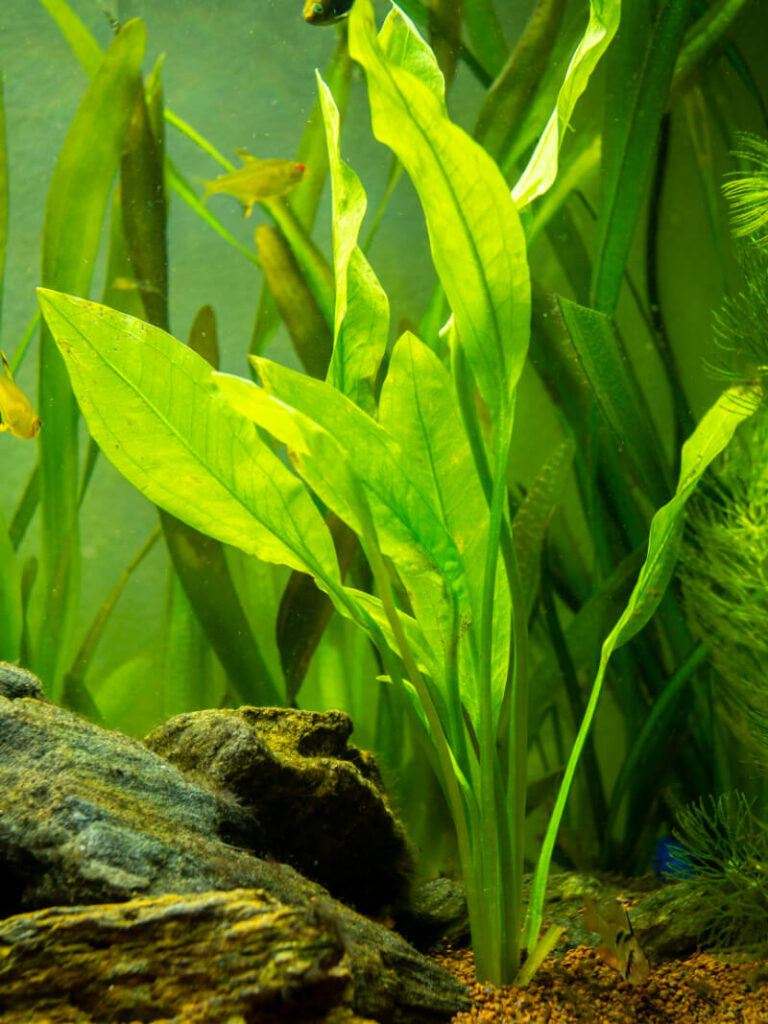
You’d be hard-pressed to find a better plant for your turtle tank than Amazon sword. It has stunning aesthetics, hearty resilience, and top-notch filtration capabilities. This particular species is not only easy to care for, but also readily available in most pet stores.
Its large and elegant appearance adds a touch of beauty to your turtle tank while providing necessary hiding spots for your shelled friends. The broad leaves are perfect shelters where turtles can retreat and rest.
What makes Amazon sword even more appealing is its dual role as a natural filter due to its size. It helps keep the water clean, which would otherwise be a daunting task considering how messy turtles can be. Additionally, while your turtles may occasionally nibble at them or go on an uprooting spree since they don’t taste particularly good, these plants are tough enough to survive such encounters.
If it does get uprooted by curious turtles, it’s nothing you can’t fix. Simply anchor it back into the substrate with a rock and it’ll continue thriving in no time!
2. Java Moss
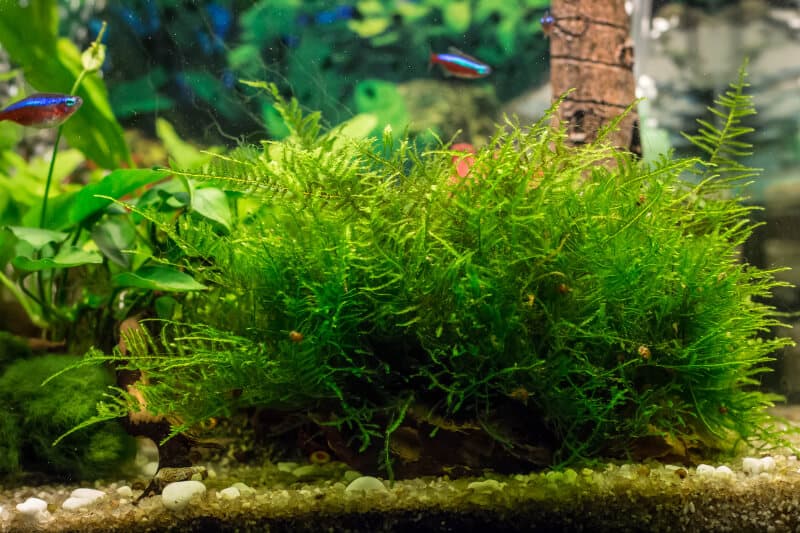
Consider some Java moss for your turtle tank due to its adaptability and low maintenance requirements. It can thrive in dimly lit or murky water environments while serving as a lush green carpet that your aquatic friends can nibble on without making a mess.
This hardy plant from the Hypnaceae family is perfect for beginners due to its fast growth rate and minimal light and CO2 demands. It’s capable of growing up to 5 inches tall, which provides ample cover for hatchlings and younger turtles. The pH tolerance range between 5.0-8.0 gives it versatility across different tank conditions.
Java moss, scientifically named Taxiphyllum barbieri, can be spread out like a carpet across the substrate of your turtle tank or attached to driftwoods and rocks. Its unique ability to flourish under varying conditions makes it an excellent choice for adding natural aesthetics to your turtle tank without requiring rigorous upkeep.
While its appearance might not be as striking compared to other plants, its practical benefits are what make it truly shine in turtle tanks. From providing hiding spots to serving as an additional snack while not dirtying the water, Java moss can enhance the overall appeal of your turtle’s habitat while meeting their needs with ease.
3. Anubias
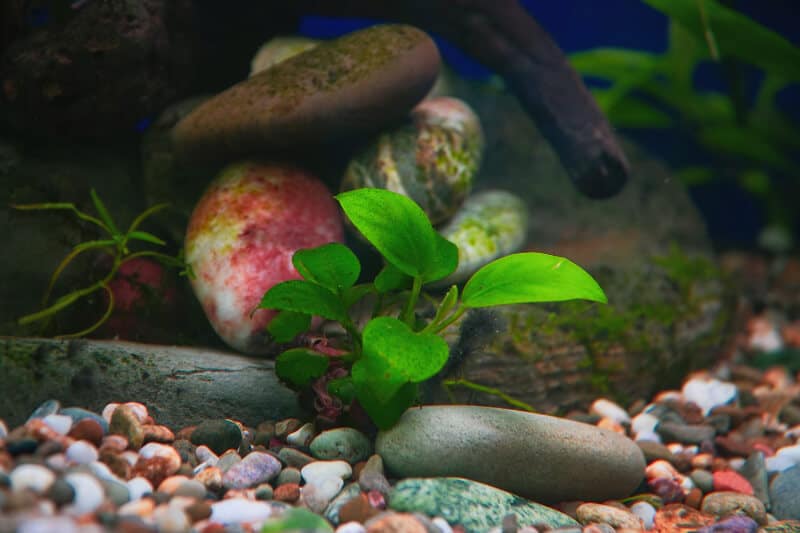
Imagine the tranquility of watching your beloved pet turtles swimming around lush, large leaves that not only beautify their home but also offer a peaceful sanctuary. This is what you get when you introduce the Anubias into your turtle tank.
A popular choice among turtle owners, this striking plant with its gorgeous leathery leaves adds a touch of nature to any tank. It originates from West Africa and thrives in temperatures between 72 and 82 degrees Fahrenheit (conditions that are easily achievable in most turtle tanks). What’s more, even if you’re just starting out, you’ll find it easy to care for since it grows slowly and requires low to moderate light.
Planting and maintaining Anubias is hassle-free too! You can anchor it at the bottom using a substrate like Fluorite or gravel or tie it to a weight such as a rock. Its growth rate may be slow, but this plant’s longevity and resilience make it an excellent choice.
The best part? Your turtles aren’t likely to nibble on this plant which means no mess for you to clean up! Plus, its pH preferences are flexible so there’s no need for constant monitoring or adjustments. All these factors make Anubias a great plant for turtle tanks, and one you should definitely consider.
4. Hornwort
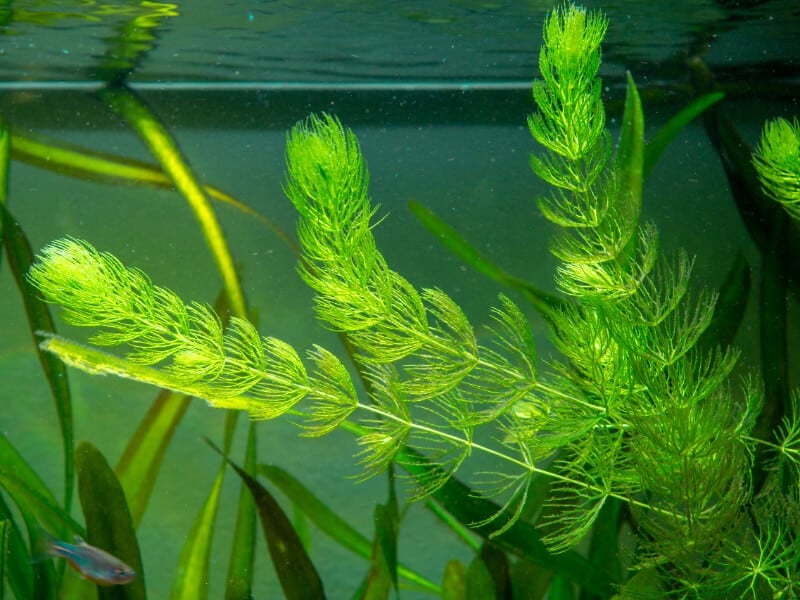
If you’re seeking a resilient and elegant addition to your turtle tank, look no further than hornwort. Known by its scientific name Ceratophyllum demersum, this popular underwater plant is perfect for both beginner and expert enthusiasts.
Not only does it have an attractive appearance with its fast-growing, feathery fronds, but it also thrives under moderate lighting conditions. The hornwort can withstand temperatures ranging from 60° to 85° F and prefers a water pH between 6.0-7.5, making it adaptable to various environments within these parameters.
One of the main reasons why hornwort is considered one of the best plants for turtle tanks lies in its versatility and low-maintenance nature. You can either anchor it down using a suction cup or let it float freely. It doesn’t require any substrate and is very easy to care for. All it really needs is a bit of light.
Turtles tend to avoid eating hornwort, but it’s harmless even if they do. This hardy plant also has excellent filtration properties that can efficiently remove nitrates from the water, maintaining great water quality for your pets.
5. Moneywort
You’ll find that moneywort, with its rapid growth rate and vibrant green hue, is a wonderful addition to any aquatic setup. We recommend it not just for its aesthetic appeal, but also its practically foolproof maintenance.
This plant thrives in various lighting conditions and doesn’t require CO2 supplementation for stable growth. Even in simple turtle tanks with low lighting, the moneywort can still thrive, albeit at a slower pace. Its adaptability makes it an excellent choice for beginners or anyone who wants to add some color without having to worry about complicated upkeep.
Moreover, this plant’s edibility factor adds unique value to your turtle tank. Moneywort is completely safe for turtles to consume, so don’t be surprised if you see your shelled friend munching on it from time to time. And if it gets eaten, it regrows quickly due to a fast growth rate.
6. Java Fern
Java fern can be a resilient and adaptable addition to your turtle tank that can transform the habitat into an elegant, natural oasis. This plant has a low to moderate growth rate and can reach up to 10 inches in height, making it perfect for tanks of all sizes.
Its light demand is minimal, meaning it thrives even under the UV lights that are necessary for your turtle’s health. Java fern also acts as a natural filter by eliminating contaminants from the water, which contributes greatly to maintaining a clean and healthy environment for your pet.
In terms of maintenance, you’ll find this plant doesn’t require much effort or expertise. It needs to be anchored onto driftwood or rocks since it doesn’t grow well in substrate, but attaching it is pretty simple. There’s also no need for CO2 supplementation due to its low requirement level.
Expert Tip: While this plant is hardy enough to survive in different lighting conditions, very low-light environments may slow its growth down.
7. Water Sprite
Water sprite is an easy-to-maintain and fast-growing plant that can add a lush green touch to your turtle tank. Known scientifically as Ceratopteris thalictroides, this plant grows up to 24 inches tall and requires a moderate amount of light along with high CO2 levels for optimal growth. Despite its fast growth rate and specific requirements, it’s known for being quite user-friendly.
You can either plant it in your tank’s substrate or let it float on the surface, depending on what suits your aesthetic preferences and tank conditions best.
However, there’s more to consider than just aesthetics when adding this plant to your turtle tank. It’s not the most robust choice due to its delicate nature (turtles tend to find it appealing as food), especially smaller plants. This could lead to some challenges in maintaining its presence in the habitat. On top of that, careful trimming is necessary since it has potential for rapid growth that might break the water’s surface if unchecked.
Despite these considerations, introducing water sprite into your turtle tank is still worth considering due to its beauty and ease of maintenance.
8. Rosette Sword
Rosette sword is an aquatic plant that’s known for its appearance and hardy nature. Unlike many plants that often end up as turtle snacks, turtles generally tend to avoid nibbling on Rosette swords. If this is your main concern with finding a plant for your turtle tank, we’d recommend giving this species a shot.
Also, it’s beginner-friendly which makes it a perfect pick if you’re still getting your bearings when it comes to maintaining a turtle tank.
Growing and maintaining a Rosette sword demands attention to the substrate and tank size. The plant needs some soil at the bottom of the turtle tank to grow optimally, but this can be easily arranged with commercially-available aquarium substrates.
As for size considerations, ensure that your aquatic setup has ample space to accommodate this plant’s growth while still providing enough room for your turtles. Not only will this lovely greenery provide some aesthetic appeal, but it will also help maintain water clarity and increase oxygen levels in your tank.
9. Anacharis
Anacharis is a popular aquatic plant that’s easy to care for while also providing multiple benefits for your little shelled friends. This plant is excellent for beginner turtle tank keepers as it requires minimal maintenance and grows at a fast pace, ensuring there’s always enough in your tank.
Anacharis can thrive in water with a pH level of 6.5-7.5 and moderate lighting conditions, making it adaptable to various environments. Its natural ability to anchor itself onto the bottom of the tank means you don’t need special tools or techniques to get it settled.
One major benefit of having Anacharis as a live plant for your turtle tank is its role as a natural filtration system, helping maintain clean water while providing ample cover due to its dense growth pattern. Turtles such as red-eared sliders and painted turtles will appreciate this plant not only for shelter, but also as an occasional snack (especially when they’re young).
10. Water Wisteria
Another one of the best plants for turtle tanks is water wisteria. This aquatic plant (scientifically known as Hygrophila difformis) is a fast-growing species that can reach up to 20 inches in height and spread outwards to a width of 10 inches. It’s not just its size that makes it appealing; it’s also incredibly hardy, making it suitable even for tanks with larger turtles.
One of the key advantages of water wisteria is its ease of propagation. You can simply cut a leaf and easily use it to grow a new plant, allowing you to have as many as you want in your tank.
Unlike many of the other plants on this list, water wisteria requires stronger lighting conditions for optimal growth. Also, keep in mind that it needs a fair amount of space in the tank due to its potential size.
11. Pennywort
If you’re searching for a vibrant and easy-to-maintain plant for your turtle tank, look no further than Brazilian pennywort. This plant is renowned for its fast growth rate and amazing appearance.
In just a matter of weeks with proper care this plant can grow several inches tall. It’s an excellent choice for those who want vegetation that doesn’t require high levels of light or CO2 and isn’t too demanding in terms of maintenance.
Another benefit is that its versatility allows you to either plant it in the substrate or let it float freely around your tank.
But there are a few things you need to keep in mind when considering this option. Brazilian pennywort may not be as hardy as some other plants on this list, which means that it could be damaged by adult turtles biting it. Additionally, this plant does require a good amount of light and plenty of nitrogen.
Also, remember that while it’s ideal for small turtle tanks, space could become an issue as your turtle grows bigger. Make sure you take all these factors into account before deciding on whether the Brazilian pennywort is the right fit for your setup!
Why You Should Consider Live Plants For Your Turtle Tank
The idea of transforming your turtle tank into a vibrant and thriving ecosystem is appealing to many owners. Live plants can be more than just an attractive decoration, they offer numerous benefits that improve your turtle’s well-being and the overall quality of your tank environment.
The diverse colors, leaf shapes, and textures bring life to your tank, creating a natural-looking habitat that closely resembles what turtles would encounter in the wild. This not only enhances visual appeal but also provides comfort and creates engaging spaces for your turtles to explore, hide, or even snack on.
In addition to aesthetics and providing natural space for play and exploration, the best live plants for turtle tanks can contribute to maintaining water health. They filter harmful compounds like ammonia, nitrites, and other unwanted organic matter. They can also prevent unsightly algae growths and spots on aquarium glass while also enriching water with oxygen, which discourages unwanted bacteria growth.
What To Look For In A Plant For Your Turtle
There are a few traits you should look for when considering live plants for your turtle tank. Here are the main factors to think about.
Safe
Ensuring the safety of your shelled friend is paramount, so it’s crucial to confirm that every plant in the turtle tank isn’t just visually appealing, but completely harmless too.
This means you’ll need to get well-acquainted with each plant type before making a purchase. While turtles tend to be pretty hardy, certain plants can pose serious risks if ingested. Some species can be outright toxic to turtles and lead to severe health issues or even prove fatal.
Don’t make the mistake of assuming that just because your turtle tends to avoid eating the plants in its tank that they are safe from harm. Accidental ingestion could occur at any time, which could potentially lead to devastating consequences.
This means that thorough research should be done for each plant before adding them to your turtle tank. And remember: Certain plants like milkweed, ivy, and water hemlock are known toxins for turtles and should always be avoided. By making informed decisions about the flora in your turtle’s environment, you’re setting them up for a happy and healthy life under your care.
Low Light Requirements
Opting for flora that doesn’t demand high light levels can simplify the upkeep and time you need to spend.
Selecting plants that require less light means you won’t have to install special lighting or worry about keeping the tank in direct sunlight. This gives you more flexibility in where you can place your turtle tank while also reducing maintenance time and cost.
This doesn’t mean you can’t include certain plants with more light requirements, but you should be aware of this ahead of time so you know what you’re getting into.
Can Thrive In Various Conditions
Selecting live plants for your turtle tank that can flourish in different conditions is a smart move for any aquatic habitat. While turtles can sometimes be a bit rough with the vegetation in their home, hardy plants have the durability to endure such interactions and even thrive in them.
These tough species are not easily uprooted or damaged, giving them the chance to grow robustly despite the occasional nibble or dig from your pet. The added benefit of these resilient plants is their ability to adapt to various water conditions..
Choosing such adaptable plants also takes some pressure off you as a pet owner. With robust aquatic plants in your turtle tank, you won’t need to worry about frequent replacements due to plant damage or suboptimal growth. This resilience doesn’t mean you should neglect proper care and maintenance; it simply means these types are more forgiving and require less meticulous care compared to delicate counterparts.
Whether it’s light availability, temperature shifts, or changes in water quality, hardy plants can weather these elements better. This ensures a healthier and more aesthetically pleasing habitat for your beloved turtles.
Closing Thoughts
When setting up your turtle tank, it’s important to choose plants that are not only safe and non-toxic, but also rather hardy.
As long as you do this, you shouldn’t have any problems!

